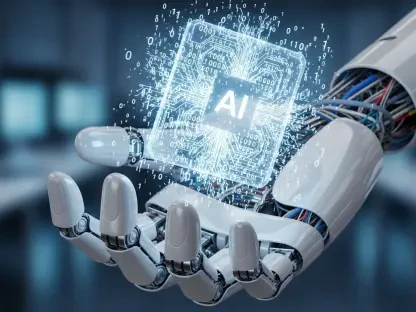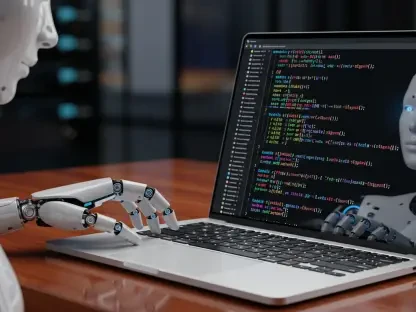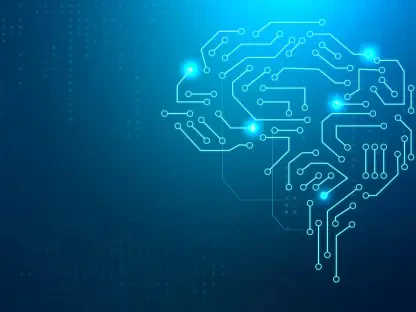The cybersecurity landscape is rapidly evolving, and by 2025, it will be significantly shaped by advancements in artificial intelligence (AI), quantum computing, and the increasing reliance on Software as a Service (SaaS) applications. This article delves into expert predictions and insights on emerging trends, potential threats, and the evolution of attack strategies within this context.
AI’s Double-Edged Sword
AI in Cyber Defense and Offense
Artificial intelligence will play a crucial role in both enhancing cybersecurity defenses and enabling more sophisticated cyberattacks. On the defensive side, AI-driven threat detection systems will analyze massive datasets to provide predictive threat intelligence, helping organizations stay ahead of potential threats. These systems will be capable of identifying patterns and anomalies that human analysts might miss, thereby improving the overall security posture. For example, anomaly detection algorithms can pinpoint unusual behavior indicative of a cyber threat, allowing for preemptive measures to be taken before any real damage is done.
Conversely, AI will also be a powerful tool for cybercriminals. Generative AI (GenAI) will facilitate the creation of sophisticated attacks, including phishing, deepfakes, and zero-day vulnerability exploitation. AI will assist in developing new malware variants and improve the effectiveness of phishing lures, making it easier for attackers to bypass traditional security measures. The automation capacities of AI mean that advanced cyberattacks previously requiring considerable expertise can now be executed with greater ease. This dual-use nature of AI in cybersecurity—benefiting both defenders and attackers—embodies a double-edged sword, elevating the stakes in the cybersecurity arena.
Generative AI and Sophisticated Attacks
Generative AI will revolutionize the way cyberattacks are conducted. By automating the creation of convincing phishing emails and deepfake videos, attackers will be able to deceive even the most vigilant users. These AI-generated attacks will be highly personalized, increasing their chances of success. For instance, imagine an email that mimics the writing style of a targeted individual’s colleague, complete with realistic grammar and syntax. Additionally, AI will enable the rapid development of new malware variants, making it difficult for traditional antivirus solutions to keep up, necessitating a shift in how defenses are implemented.
AI will also streamline the entire cyberattack chain, from reconnaissance to execution. Multimodal AI systems will automate tasks such as phishing, malware generation, and infrastructure management, allowing less skilled threat actors to launch complex attacks with minimal effort. This democratization of cybercrime will pose a significant challenge for cybersecurity professionals. AI won’t just assist in the initial stages of an attack; it will also facilitate post-attack management, such as data exfiltration and cover-up activities. As AI-driven attacks become more sophisticated, cybersecurity teams will need to develop equally advanced defenses, focusing on AI-guided threat detection and response.
Quantum Computing Threats
The Impact on Encryption
Quantum computing is poised to disrupt the field of cryptography. Current encryption methods, which rely on the difficulty of factoring large numbers, will be rendered obsolete by the immense computational power of quantum computers. This will necessitate a shift to quantum-resistant cryptographic algorithms to ensure data security in the post-quantum era. The transition to these new algorithms will not be instantaneous; it will require meticulous planning and execution. Cybersecurity professionals will need to conduct comprehensive audits of their existing encryption strategies to identify vulnerabilities.
Organizations must begin transitioning to these new algorithms to protect their sensitive information. Governments and large enterprises are already taking steps to adopt post-quantum cryptography, but smaller organizations must also prioritize this transition to mitigate future risks. The urgency for implementing quantum-resistant encryption cannot be overstated. While quantum computers may still be a few years away, the data encrypted today using current methods could be vulnerable to future decryption attacks, putting sensitive information at risk. The development of robust quantum-resistant cryptographic solutions will be a cornerstone of cybersecurity strategies moving forward.
“Steal-Now, Decrypt-Later” Strategies
Adversaries are likely to adopt “steal-now, decrypt-later” strategies, where they steal encrypted data today with the intention of decrypting it once quantum computers become available. This underscores the urgency of implementing quantum-resistant encryption techniques. The potential for future decryption threats means that organizations must act swiftly to safeguard their data. They should develop cryptographic asset registers to track and manage their encryption mechanisms, ensuring that any updates to quantum-resistant algorithms are applied comprehensively.
Organizations must develop cryptographic asset registers and overhaul their encryption strategies to safeguard their data against future quantum threats. This requires a multi-faceted approach that includes training employees, investing in new technologies, and collaborating with cryptographic experts. Additionally, regular security audits and updates will be crucial in maintaining a robust encryption posture. The transition to quantum-resistant cryptography will demand both time and resources, but it will be indispensable for protecting sensitive data in the quantum computing era.
SaaS Security Concerns
Increasing Sophistication of SaaS Threats
As SaaS applications become more prevalent, they will face increasingly sophisticated threats. These threats will stem from advancements in AI, which will lower the entry barriers for less skilled attackers, enabling them to exploit SaaS vulnerabilities and bypass security measures. SaaS platforms, given their widespread use, present an attractive target for cybercriminals. Threat actors will craft convincing phishing campaigns targeting SaaS users, leveraging AI-powered bots to launch large-scale attacks with minimal effort. This trend will necessitate heightened vigilance and advanced security protocols for SaaS providers and users alike.
Organizations must prioritize securing their SaaS environments by implementing stringent access controls and continuous monitoring. Leveraging AI for threat detection and response will be crucial in mitigating these risks. With the dynamic nature of SaaS applications, manual security measures will be insufficient. Only through the continuous application of AI-driven monitoring and adaptive threat responses can organizations hope to stay ahead of the evolving threat landscape. This proactive approach will not only help in detecting potential threats but will also ensure rapid response to neutralize any detected vulnerabilities.
AI-Powered Bots and Large-Scale Attacks
AI-powered bots will play a significant role in enabling large-scale SaaS attacks. These bots can automate tasks such as credential stuffing, phishing, and vulnerability scanning, allowing attackers to target multiple SaaS applications simultaneously. The scale and speed at which these bots operate will pose a significant challenge for cybersecurity teams. The efficacy of AI bots in executing repetitive tasks with precision means that traditional defenses will be overwhelmed, paving the way for more successful incursions.
To counter these threats, organizations must adopt advanced AI defenses and automated workflows. AI-guided remediation will reduce manual workloads and improve the accuracy and speed of security responses, helping organizations stay ahead of attackers. By integrating AI into their security frameworks, organizations can ensure real-time monitoring, rapid threat detection, and automated responses to neutralize threats. This also includes regular updates and patches to AI systems, ensuring they are capable of handling emerging threats. In an environment where AI-enhanced threats are the norm, equally robust AI defenses will be imperative.
Cloud Security Challenges
Complexity and Importance of Cloud Environments
Cloud environments will remain a significant target for cybercriminals due to their complexity and importance. As organizations continue to migrate their operations to the cloud, the attack surface will expand, providing more opportunities for threat actors to exploit vulnerabilities. The multifaceted nature of cloud infrastructure—spanning storage, networking, and applications—means that vulnerabilities could arise from any component, amplifying the challenge for cybersecurity teams. AI will assist in identifying and exploiting misconfigurations in cloud security, making it essential for cloud security teams to stay vigilant.
To address these risks, organizations must implement robust cloud security measures, including stringent access controls, regular security assessments, and continuous monitoring. Leveraging AI for cloud security will be crucial in keeping pace with increasingly sophisticated threats. AI-driven systems can analyze vast amounts of data, identifying anomalies and potential threats in real-time, thereby reducing the risk of successful attacks. By adopting such proactive measures, organizations can ensure their cloud environments remain secure even as they scale.
Leveraging AI for Cloud Security
To keep pace with increasingly sophisticated threats, cloud security teams must leverage AI for threat detection and automated remediation. AI-driven systems can analyze vast amounts of data to identify potential threats and respond in real-time, reducing the risk of successful attacks. Continuous monitoring and regular security assessments will be vital in maintaining a robust cloud security posture. For instance, AI algorithms can detect unusual login patterns that might indicate an ongoing breach, allowing teams to respond swiftly.
By integrating AI into their cloud security frameworks, organizations can automate the detection and mitigation of threats, ensuring a proactive approach to cloud security. This involves not only deploying AI tools but also continuously training them to adapt to new threat patterns. Moreover, regular updates and patches to cloud infrastructure will be essential in closing any loopholes that cybercriminals might exploit. With the complexity of cloud environments growing, a reliance on traditional security measures will no longer suffice; advanced, AI-driven strategies will be imperative for robust cloud security.
Insider Threats and Zero Trust
The Rise of Insider Threats
Insider threats will become more prominent as organizations move towards distributed and cloud-based environments. Employees, contractors, and third-party vendors often have legitimate access to the systems and data, which can be exploited maliciously or accidentally. The traditional perimeter-based security model becomes less effective in such scenarios, necessitating a shift towards more granular security measures. A zero trust architecture, which assumes that threats could originate from within the network, will become increasingly essential.
Organizations will need to expand their zero trust strategies to encompass all users and devices, integrating continuous authentication and authorization policies. A behavioral understanding dimension will be incorporated into these approaches to detect and mitigate insider threats. This involves monitoring user actions and analyzing them for any anomalies that might indicate malicious intent. By understanding normal user behavior, security systems can flag deviations that require further scrutiny, thereby preventing potential breaches.
Zero Trust Framework and Behavioral Analytics
A shift towards zero trust architectures and the integration of behavioral analytics as part of this framework will be crucial. The experts point to the need for continuous verification and monitoring to address insider threats and ensure robust security postures. This zero trust model rests on the principle of “never trust, always verify,” requiring rigorous checks at every stage of user interaction with the systems. This approach, combined with behavioral analytics, will enable organizations to detect even subtle signs of insider threats.
By continuously monitoring user actions and analyzing their behavior, organizations can identify and mitigate insider threats before they cause significant damage. These measures will include granular access controls, real-time activity monitoring, and adaptive security policies. Additionally, educating employees about security best practices will be crucial in minimizing accidental insider threats. With the rise of distributed and cloud-based work environments, adopting and evolving zero trust strategies will be indispensable in safeguarding organizational assets.
Conclusion
The cybersecurity landscape is transforming rapidly, and by 2025, it will be profoundly influenced by advances in artificial intelligence (AI), quantum computing, and a growing dependence on Software as a Service (SaaS) applications. These changes bring a wave of new trends, potential threats, and the evolution of attack strategies. Experts forecast that AI will play a crucial role in enhancing both defensive and offensive measures in cybersecurity. While AI can help detect and respond to threats more efficiently, it also offers cybercriminals new tools to launch more sophisticated attacks.
Quantum computing, although still in its infancy, poses a significant future challenge. Its ability to solve complex problems at unprecedented speeds could render current encryption methods obsolete, making sensitive data vulnerable unless new encryption techniques are developed and widely adopted. As organizations increasingly rely on SaaS applications, they must adapt to the unique security challenges these platforms present. SaaS solutions, while convenient, can also be gateways for cyberattacks if not properly managed and secured.
In summary, the future of cybersecurity will be heavily shaped by technological advancements and the strategic use of new technologies. Organizations must stay ahead of the curve, continuously adapting to the changing landscape to protect their data and systems from emerging threats. The collaboration between tech innovators and cybersecurity professionals will be essential in building a more secure digital environment by 2025.









